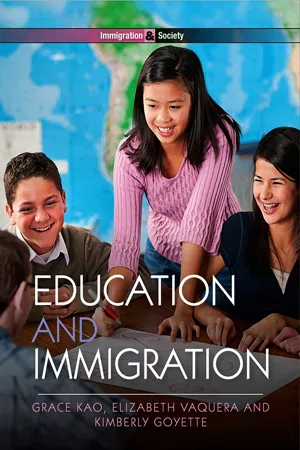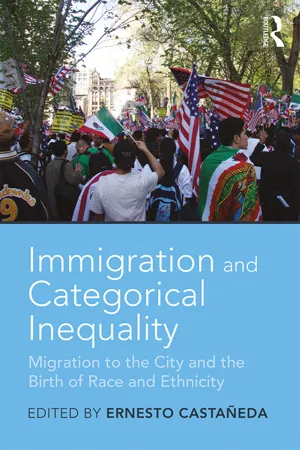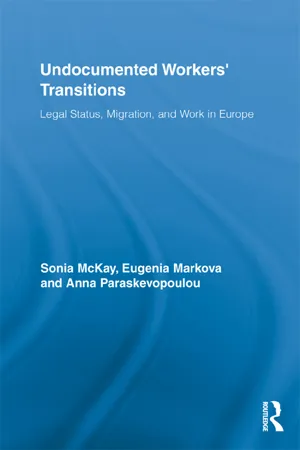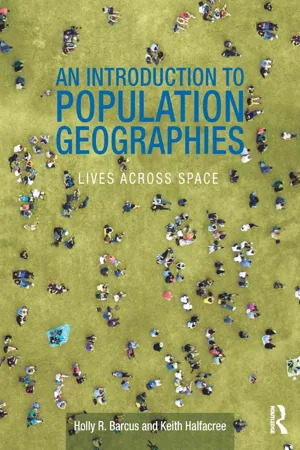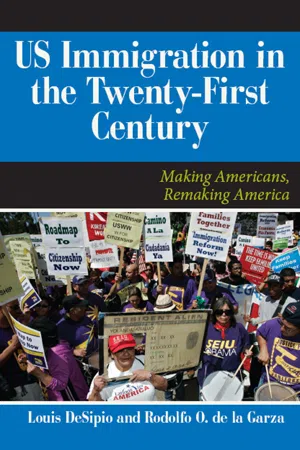History
Immigration
Immigration refers to the movement of people from one country to another with the intention of settling permanently. Throughout history, immigration has been a significant factor in shaping the cultural, social, and economic landscapes of nations. It has often been driven by factors such as economic opportunities, political instability, and social or religious persecution.
Written by Perlego with AI-assistance
Related key terms
Related key terms
1 of 4
Related key terms
1 of 3
6 Key excerpts on "Immigration"
- eBook - ePub
- Grace Kao, Elizabeth Vaquera, Kimberly Goyette(Authors)
- 2013(Publication Date)
- Polity(Publisher)
Throughout the chapter, we underscore how changes in Immigration regulations are related to the characteristics of the immigrants arriving to the US. We also describe how immigrant groups were initially positioned within the socioeconomic, ethnic, and racial hierarchy of the US, and how, for some groups, their relative racial status has changed over time. The historical context of Immigration in the last 200 years underlies the theoretical shifts among Immigration scholars discussed in the previous chapter: from traditional understandings of assimilation that assumed unidirectional upward mobility, to more recent ideas that allow room for downward socioeconomic mobility among immigrants. Throughout the chapter, notice the opposition Americans have had to Immigration and their concerns about the “assimilability” of the most recent arrivals time after time. The groups those feelings were directed toward and the regulations that were in place to restrict or prevent their migration to the US have changed over time, however. These shifts in how and which immigrants came to the US as well as the changing context of reception have affected their opportunities to obtain a good education and, consequently, their social mobility over time. We ask the reader to consider: How do US policies toward Immigration influence whether immigrants become “American?” How might these policies affect the jobs they get and the places they live? In later chapters, we will ask the reader to consider how the policies that lead to these patterns may influence the educational achievement and attainment of both immigrant adults and the children in immigrant families.The two centuries that are the focus of this chapter can be divided into several distinct eras of Immigration. In part, we have characterized these periods by the national-origin and numbers of immigrants. Within these periods, notice the relationship between the racial and ethnic makeup of immigrants and changes in Immigration restrictions that support differential treatment of certain immigrant groups. As you read the chapter, refer to figures 3.1 and 3.2 - eBook - ePub
Migration Practice as Creative Practice
An Interdisciplinary Exploration of Migration
- Dieu Hack-Polay, Ali B. Mahmoud, Agnieszka Rydzik, Mahfuzur Rahman, Paul Agu Igwe, Gary Bosworth(Authors)
- 2021(Publication Date)
- Emerald Publishing Limited(Publisher)
Part 1 Historical and Contemporary Perspectives on Migration Here we are concerned with the historical construction of migration and what that signifies in the modern global world. We consider various discourses on migrants and how these discourses can often undermine the creative energy brought by migrants. Chapter 2 The Historical Construction of Migration Dieu Hack-Polay Introduction The history of our world is predominantly a history of migration. The history of humankind leads us to observe that only a few communities and populations, if any at all, could claim to have lived in the same geographical and social spaces all the time. Indigenous peoples? It is estimated that there are 35–40 million forced migrants and displaced people around the world a decade ago (Williamson, 1996). In the same period, Population Report (1996) put the figure higher at 125 million international migrants, with most living in the developed (e.g. Western Europe, North America and Australia). However, the figure advanced by the expert agency is even higher. Moreover, the United Nations reports over 272 million international migrants around the world in 2019 (UN, 2019). This figure equates to over 2% of the total world population. The number of people living outside of their native land is significantly higher if statistics were able to include migrant workers and other voluntary migrants accurately. Some of the primary reasons that have led people to be on the move have included and still include the search for better conditions of subsistence, work or trade (economic reasons), safety from disaster and human persecution by oppressors and State violence, etc - eBook - ePub
Immigration and Categorical Inequality
Migration to the City and the Birth of Race and Ethnicity
- Ernesto Castañeda(Author)
- 2017(Publication Date)
- Routledge(Publisher)
3 Immigration or Citizenship? Two Sides of One Social History Josiah Heyman Introduction Drawing on Charles Tilly’s seminal work on citizenship, I propose that we refocus our approach to Immigration by combining in one single view the historical development of nation-state membership (termed “citizenship”) and internal and international migration. 1 I argue that the characterization of newly arriving outsiders (“immigrants”) makes sense only in contrast to the gradual definition and clarification of insiders (“citizens”). I am thus critical of social, economic, and political accounts that focus only on immigrants or only on citizens, without seeing them as outcomes of simultaneous if contrastive processes. These social positions are partly a result of the gradual rise of nation-states, which is obvious, but they are also affected directly and indirectly by capitalism, including the attraction of immigrant populations into growth centers, the movement of capital to new sites of production (sometimes glossed as globalization), and the decline of old sites of capital investment. State formation is likewise funded by revenues from the capitalist economy. I thus suggest we need to envision three interweaving processes: human migration, internal and international; nation-state consolidation and the rise of citizenship regimes; and capital mobility, accumulation, and withdrawal. I draw my inspiration from Tilly’s concept of dual processes shaping the modern world, capitalism and nation-state formation (Tilly 1984, 1992). 2 “Immigrant” is an emergent outcome of the intersection of those processes. I also draw on his analysis of the history of citizenship, including the state-population relationship developed around taxation, military service, political inclusion, and rights (Hanagan and Tilly 1999; Tilly 1996). While Immigration has attracted widespread scholarly and political attention (an important synthesis is Massey et al - eBook - ePub
Undocumented Workers' Transitions
Legal Status, Migration, and Work in Europe
- Sonia McKay, Eugenia Markova, Anna Paraskevopoulou(Authors)
- 2012(Publication Date)
- Routledge(Publisher)
2 Migration in a European Historical Perspective
One of the central ways in which the link between the people and the state is expressed is through the rules governing citizenship and naturalisation. (Castles and Miller, 2009:16)The importance of the nation state in determining who is part of it and who is not, as the above quote suggests, is highly relevant to any study of migration. However, migration is not a new phenomenon of social life nor was it one that was the subject of significant state controls and regulations before the start of the 20th century. This point is of specific relevance to the undocumented migration of today, as it is not only part of an overall migratory movement but, we would assert, is the direct result of such controls and regulations. For us, therefore, it has been important to begin by focusing on the key reasons for such a change. How did migration policies move from being very limited in their scope, to the restrictions that we see today? Could the aims of states to limit entry for very specific groups of workers, be seen as solely serving the short-term interests of the labour market? The chapter therefore discusses the main types of migratory movements occurring in the 20th and early 21st centuries, although to place this in its context we also provide a brief overview of migration throughout European history. We have concentrated mainly on European developments, but within the wider context of international migration. We demonstrate that although European policy today is based on keeping people out, for most of their own history Europeans were themselves migrants. As the subject of migration covers many and complicated aspects, we have focused on what we see as the most significant developments that help us in understanding the concept of undocumented migration today. - eBook - ePub
An Introduction to Population Geographies
Lives Across Space
- Holly R. Barcus, Keith Halfacree(Authors)
- 2017(Publication Date)
- Routledge(Publisher)
CHAPTER 5Placing human migration5.1 INTRODUCTION: DEFINING MIGRATION
5.1.1 What is migration?
Migration remains the most widely studied and examined element within Population Geography (Boyle 2003, 2004). Moreover, whilst Geographers have played a pivotal role in shaping our contemporary understanding of it, the topic is of interest to numerous academic disciplines, including Demography, Sociology, Political Science, Economics and Anthropology (Brettell and Hollifield 2008a). In this respect, approaching migration as it occurs within the life course has considerable potential for bringing together a scattered body of scholarship often fragmented by “disciplinary partitioning” (Olwig and Sørensen 2002: 7).But what exactly is migration? Initially put, as in a recent textbook, it is “the movement of people to live in a different place” (Holdsworth et al. 2013: 96) or a “permanent change in residence.” It is residential relocation. Or, as expressed in UK and US censuses, a migration is deemed to have occurred when one’s “usual address” has changed within the last 1 or 5 years, respectively (ONS 2013; USCB 2013). Simple, then, one might think! However, as Holdsworth et al. (2013: 98) also noted, careful consideration of these definitions immediately raises a host of questions: what precisely is meant by “different place,” “live in,” “permanent,” or “usual address”? Consequently, by the end of the present chapter, “migration” will have been demonstrated to be at least as complex and multi-dimensional a concept as Chapter 4 revealed “fertility” to be.Starting with the idea of “different place,” the type of areal unit(s) involved in a migration is an initial important consideration when defining it specifically. A crucial starting point is whether a political boundary is crossed during a move. For example, an individual could move from one county to another within the same US state or from one state to another. Both moves are conventionally described as intra-national or internal migration, because neither involves leaving the US. In contrast, a move from the US to Canada, crossing an international border, is an international migration - eBook - ePub
U.S. Immigration in the Twenty-First Century
Making Americans, Remaking America
- Louis DeSipio(Author)
- 2018(Publication Date)
- Routledge(Publisher)
Chy Lung v. Freeman, 92 U.S. 275, 1875), today there are at least 1,500 formal agreements between the federal government and state and local criminal justice agencies empowering state and local officials to enforce Immigration laws. In principle, none of these agreements allows states to initiate policies that contradict federal standards. However, enforcing this boundary requires continuous vigilance and negotiation, especially because Immigration policy comes into conflict with domestic policies, particularly those concerning labor, education, and health, as well as foreign policy. Faced at times with seeming federal inaction in enforcing Immigration laws, states have begun to express their dissatisfaction by passing laws like Arizona’s S.B. 1070 that usurp what had traditionally been a federal government responsibility. We analyze the extent to which such state efforts to implement Immigration policies, and the rise in anti-immigrant sentiment evident in public debates over unauthorized migration, may signal a permanent shift in the nation’s response to Immigration.Ebbs and Flows of Immigration to the United StatesAs Oscar Handlin noted, the history of America is the history of the immigrant (1951: 3), and as he would have predicted, the story of American Immigration in many ways presents an overview of the major phases of American history. Broadly, then, this chapter focuses on the question of deciding who we will be by looking at the ebbs and flows of Immigration to the United States and the way the nation has restricted access to its borders through various eras of Immigration. This discussion of the history of US Immigration policies provides a context for understanding the larger issues being debated by Congress in its search for comprehensive Immigration reform. The outcomes of those debates will serve as a foundation for America’s Immigration law for the early part of the twenty-first century.The first era covers the country’s earliest experiences with Immigration and immigrants, events that in some cases occurred before the founding of the country. These early experiences shaped the way the Constitution approached Immigration and settlement policy. The second era includes the first of the great waves of Immigration to the United States, in the period between 1841 and 1860, when populations perceived as different from the dominant populations entered the country in large numbers. In this First Great Wave of Immigration, more than 1 million Irish and Germans entered the United States. The third phase begins with the end of the Civil War and continues to World War I, and is known as the Second Great Wave of Immigration. The fourth begins formally in 1965 with the civil rights movement and extends to September 11, 2001. The final era begins with the national response to 9/11 and is ongoing today.
Index pages curate the most relevant extracts from our library of academic textbooks. They’ve been created using an in-house natural language model (NLM), each adding context and meaning to key research topics.
Explore more topic indexes
Explore more topic indexes
1 of 6
Explore more topic indexes
1 of 4
